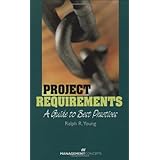
Average Reviews:

(More customer reviews)Are you looking to buy Project Requirements: A Guide to Best Practices? Here is the right place to find the great deals. we can offer discounts of up to 90% on Project Requirements: A Guide to Best Practices. Check out the link below:
>> Click Here to See Compare Prices and Get the Best Offers
Project Requirements: A Guide to Best Practices ReviewA book search on "requirements" gets 10,000 hits; "project management" gets 3,000 more. So why this one? I used Young's previous requirements books - Effective Requirements Practices (what to do) and Requirements Engineering Handbook (how to do it) - to good effect earlier in my career as a software developer, so I was interested to see what he has to offer me now in my role as a Project Manager. I was pleased to find this book gives practical, actionable guidance across the spectrum of things a PM must worry about (mostly requirements related, but even a bit beyond) in a complete yet concise way. A key "take-away" from the book is steps to mitigate my two biggest requirements issues: having the REAL requirements identified early on, and maintaining control on requirements changes/additions during the life of my projects.Compared against the Robertsons' popular "Requirements-Led Project Management," I found this book easier to read & to apply - with specific stuff you can use directly, things like a requirements-related project start-up checklist, requirements products to plan for, and a skills matrix to help you select (or grow) competent requirements manager/analysts for your project. This book manages to cover the waterfront while remaining concise (200 pp plus appendices). Wieger's "Software Requirements" is a classic reference, for example, but it's 500 pages that I don't have time to wade through; the best of Wieger's PM stuff is included here in an appendix. I particularly like the way key ideas are set off in boldface with distinctive dividers - you can get the jist of the book just by flipping pages and reading the callouts, and it helps when you go back to look for something, too.
Like Young's ERP & REH books, this one includes a couple of sections and many sidebars contributed by other luminaries, from both the US and the UK. Appendix A is Palmer's excellent paper on how to do Traceability; Appendix B is a humorous and compelling piece by Neal Whitten on "minimum requirements." Some of the best practices take a broad view of what is related to "requirements" -- the chapter on the PM's role in Quality by Dan Baker provides the best succinct description I've read of what "quality" should be on a project and how QA can make a real contribution; Stephen Waddell adds a terrific summation of Risk Management best practices in a chapter on Requirements and Risk.
The included Index isn't as comprehensive as I'd like, but the very thorough Table of Contents makes up for that somewhat -- and there's a very extensive list of references and links. In addition to the topics mentioned above, there are chapters on Key Requirements Success Factors, Partnering, Teamwork, Coaching, Communication, Process Discipline vs. Agility, Continuous Improvement, and Suggested Implementation Steps.
All in all, this is a very pithy, self-contained book to increase your effectiveness as PM and improve the management of your project. If you have the time (you must not be a PM :-), there are lots of other good, specific requirements books. If you're busy, spending just a little time with this one helps to ensure you're doing the things that are known to foster project success.Project Requirements: A Guide to Best Practices Overview"Project Requirements: A Guide to Best Practices" gives project managers tools they can assimilate and apply easily to improve project success rates, reduce development costs, reduce rework, and accelerate time to market. Based on experience and best practices, this valuable reference will help you: clarify real requirements before you initiate project work; improve management of project requirements; save time and effort; manage to your schedule; improve the quality of deliverables; and, increase customer satisfaction and drive repeat business.
Want to learn more information about Project Requirements: A Guide to Best Practices?
>> Click Here to See All Customer Reviews & Ratings Now
0 comments:
Post a Comment